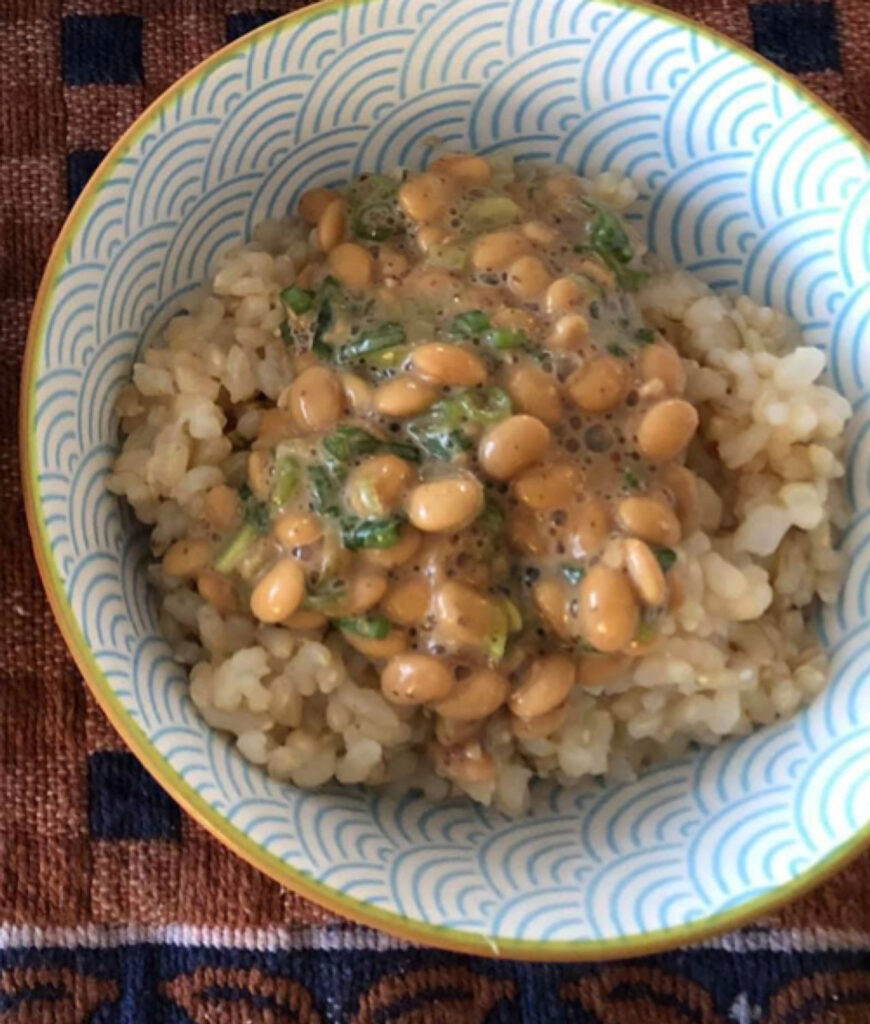- Free Shipping On Orders Over $50
- (515) 583-2198
- sales@laurasoybeans.com
First-time customers take 10% off your order with coupon code “FIRSTLAURA”. Note: Coupon and free shipping cannot be used at the same time.
First-time customers take 10% off your order with coupon code “FIRSTLAURA”. Note: Coupon and free shipping cannot be used at the same time.

What is Natto?
Natto is a traditional Japanese preparation of fermented soybeans. Often served as a breakfast food, it is paired with mustard, soy sauce and minced scallion. Natto’s pungent smell, strong flavor, and unique texture a combination of sticky and slimy make it an acquired taste for most.
A Japanese survey revealed that 70.2% of Japanese people find the taste pleasant, and others who may not find the taste of the food pleasant still eat it for health benefits. Natto is most popular in Japan’s eastern regions including Kanto, Tohoku, and Hokkaido. In fact, the Kanto region is home to the natto capital of Japan and therefore the world. Mito City, located in Ibaraki Prefecture, boasts a golden natto statue on of the south side of its central train station!
Why is Natto good for you?
Natto is rich in protein, probiotics, vitamins and minerals, all which contribute to a healthy immune system. Natto’s combination of fiber, probiotics and nattokinase may help reduce cholesterol and blood pressure levels, thus decreasing the risk of heart disease.
The fermentation of the soybeans reduces their antinutrients phytate, tannins, protease inhibitors, calcium oxalate and lectins, increases their beneficial plant compounds, and helps your body to maximize absorption of available nutrients.
Natto is rich in calcium and vitamin K2. In fact, natto has more vitamin K2 than most all other foods. Vitamin K2 plays an essential role in bone health by activating bone-building proteins that help to bring and hold calcium in your bones.
Natto is safe for most people to eat, though individuals on blood-thinning medication or with thyroid problems should consult their doctor before adding natto to their diet.
Why is natto with brown rice a winning combination?
Brown rice is a super balanced and nutritious food, however if not chewed well, it can be challenging to digest for most. Natto can aid in the digestion of brown rice. Pairing brown rice and natto together gives an immense boost to the health benefits of both superfoods at the same time!
☆Where can you purchase non-gmo soy beans?
My favorite soy beans are Launa Soybeans.
1. Small size soy beans 13Lbs. $26.95.
Laura Soybeans for Soymilk and Tofu
2. Bigger size soy beans 13Lbs. $28.50.
13 Lbs. NON-GMO Natto Soybeans 2020 Crop Best for Natto & Sprouting – Laura® Soybeans
※The Choice Is Yours I prefer natto made using the bigger size soy beans and my husband prefers the smaller size. For natto lovers I recommend bigger size, and for natto beginners I recommend smaller size.
Where can you purchase natto?
Rhapsody natural foods
Natto – (rhapsodynaturalfoods.com)
Making Natto Spores Using Rice Straw: First Step – Prepare Rice Straw
☆Making Natto Using Rice Straw
Ingredients
1 cup nongmo soy beans
3-5 Pre-boiled organic rice straw pieces
*If you keep rice straw in a freezer, before you use it, it is important to defrost for 10 to 15 minutes on the counter to bring back to room temperature
Equipment:
※Natto can be stored in the refrigerator for up to one week and can also be frozen for up to two months.
Alternative Heating Options During Fermentation
・Electric blanket.
・Oven with low temperature setting.
・Yogurt maker.
☆KEY POINTS
Sanitize all equipment & your hands very well to ensure no other bacteria interfere with the fermentation process.
Keep temperature between 110-120°F for 24 hours or more.
☆How to Eat Natto: Basic
1 cup Natto (plain)
2 teaspoons shoyu *adjust as preferred
1 teaspoon mustard
Chopped scallion, for garnish
Mix well and pour over cooked brown rice.
☆Variation of basic Natto.
1. Avocado, scallion, shoyu, mustard, sesame oil
2. Kimchi, sesame oil,
3. Grated daikon, scallion, shoyu, ※recipe from Basic
※Shredded nori is good for any way to eat natto.
☆Why is it important to mix well?
Mixing well activates the natto, further increasing its beneficial properties and adding umami – yum!
The stickiness of natto is from nattokinase natto bacteria. If your natto becomes very sticky, then you can rest assured that your natto is very good quality and condition.
☆Natto & Vegetable Lettuce Wraps
Several Boston lettuces leaves
Minced onion
Minced carrot
Minced scallion
Corn fresh or frozen
1 teaspoon shoyu
1 teaspoon mirin or maple syrup
Oil for frying
Naomi Ichikawa Esko
Founder Macrobiotics Japan, Co-founder International Macrobiotic Institute (IMI)
Naomi Ichikawa Esko is a 2010 graduate of the Kushi Institute (K.I.) in
Massachusetts. Prior to her studies at the K.I., she worked in the restaurant
industry in her native Tokyo Japan.
In 2011, Naomi established an educational center known as Macrobiotics Japan. She also managed a consulting business, providing healthy recipe and menu-building services to restaurants.
Naomi currently resides in Western Massachusetts with her husband, Edward Esko.
Get the latest updates on new products and upcoming sales
© Copyright Laura® Soybeans …. All Rights Reserved. | Web Design and Development by Saltech Systems